Leaf Fossils, What Can You Tell Us From The Past?
Oceanography’s Dr.Yige Zhang and Daianne Höfig are studying CO2 variations 15 million years ago based on leaf fossils from Clarkia Lake in northwest Idaho.
May 7, 2019
Texas A&M and Bryant University collaborative project assessing the past CO2 variation during the Middle Miocene
Dr. Yige Zhang, assistant professor in the Department of Oceanography at Texas A&M University, and doctoral student, Daianne Höfig, are participating in a joint project to examine the CO2 variation during the middle Miocene, around 15 million years ago (15 Ma). The project is a collaborative effort from Texas A&M University and Bryant University, funded by the National Science Foundation, in the scope of the Paleo Perspectives on Climate Change.
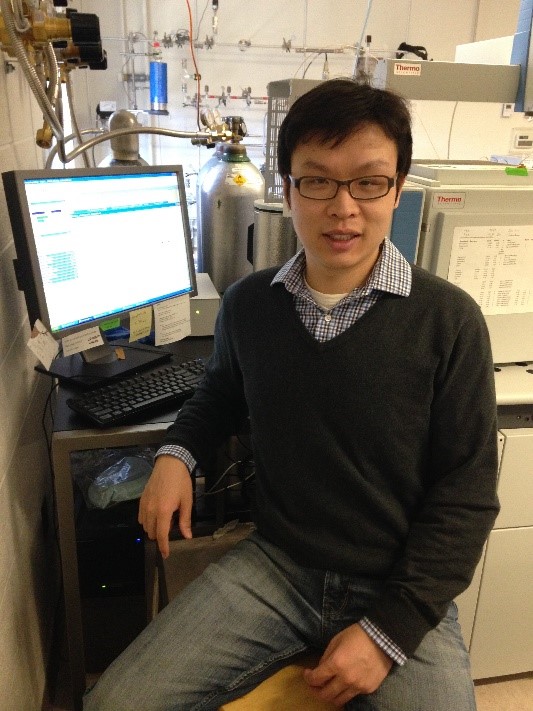
Dr. Yige Zhang, assistant professor in the Department of Oceanography.
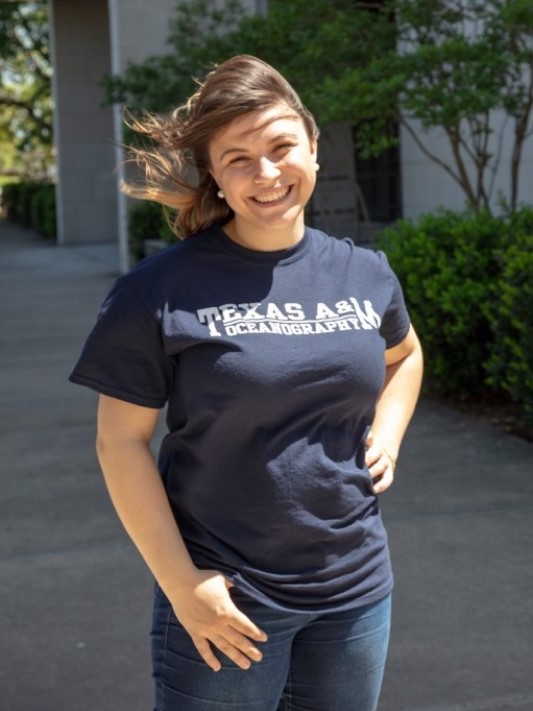
Daianne Höfig, graduate student in the Department of Oceanography. (Photo courtesy of Chris Mouchyn.)
The co-project investigators are Dr. Hong Yang and Dr. Qin Leng from Bryant University, who are senior scientists with decades of experience of paleontological studies in an ancient lake Clarkia Deposit, located in northwest Idaho, and lead the fossil morphological and anatomical part of the project; and Dr. Zhang from Texas A&M Oceanography, who spearheads the biomarker and isotopic researches for the Clarkia Lake deposit.
The project aims to unravel the elapsed time necessary to return to the background levels of carbon dioxide after massive volcanic episode, known as the Columbia River volcanism.
“We want to know how long does it take for natural processes to neutralize a CO2 spike released into the atmosphere, returning back to its background levels,” Zhang said. “The rock deposit originated from an aquatic system of approximately 15 million years old may hold the key to predict the fate of anthropogenic carbon dioxide release in the future."
Carbon dioxide (CO2) in the atmosphere and climate
Since the industrial revolution, massive amounts of carbon dioxide (CO2) have been released into the atmosphere. The atmospheric CO2 concentration level (in unit of parts per million) drastically increased and reached nearly 412 ppm in 2019. (The pre-industrial CO2 level was approximately 280 ppm). Such elevated CO2 level have significantly affected the human society and global climate, environment and the ecosystem by causing global warming, sea-level rise, and ocean acidification, according to researchers.
Carbon dioxide is one of the major greenhouse gases in the atmosphere, which plays a major role in controlling the global climate. Scientists are studying how the Earth’s climate system will respond to massive pulse of anthropogenic carbon.
To understand the interplay of enhanced atmospheric CO2 levels and the modern climatic variations, paleoclimate researchers look back into the Earth’s long history of CO2 variation. Various climate proxies have suggested that Earth’s past climate was even hotter than today. During the Eocene Epoch (56 to 34 million years ago), for example, fossils of crocodilians were found in polar regions.
How do we know the CO2 variation during the past?

Sedimentary block containing fossil leaves from the Clarkia Lake. (Photo courtesy of Dr. Yige Zhang).
Fossil leaves are important archives of CO2 history in paleoclimate studies. The critical connection between the fossil leaves and the records of CO2 variation is the photosynthetic process. Plants uptake atmospheric CO2 during photosynthesis through the ‘leaf stomata’. Stomata is the epidermis of leaves that facilitate gas exchange. The density of leaf stomata is known to correlate with partial pressure of ambient CO2 (pCO2). Based on this empirical correlation, past CO2 levels can be reconstructed by examining the stomata preserved in fossil leaves and its density.
In addition, leaf preserves different carbon isotopic signals, reflecting changes in the paleoenvironmental conditions during the photosynthesis. ‘Isotope’ is variant of elements that has same number of protons, but different number of neutrons in their nuclei. For example, carbon has two stable isotopes, carbon-12 (12C; 6 protons and 6 neutrons) and carbon-13 (13C; 6 protons and 7 neutrons). Previous studies in plant growth chamber experiments have shown that the leaf carbon isotope fractionation, in order words, preferential uptake of 12C or 13C during photosynthesis, strongly responses to plant taxonomy, precipitation, and CO2 level of the atmosphere. This suggest that carbon isotope signature of bulk leaf and biomarkers with a plant origin, so-called “molecular fossils”, can be used as paleo-CO2 proxy and tracking the past environmental conditions, such as temperature and humidity.
Where can we find fossil leaves?
In nature, oxygen is a major oxidant for degrading organic matter and microorganisms are often involved in this degradation process.
However, fossil leaves can be well-preserved in some special settings. In certain stratified lakes, the bottom water does not exchange with surface, oxygen-rich water, and once the oxygen are completely consumed by decomposing the sinking organic matters in the water column, the bottom of the lake becomes an oxygen-depleted, so-called ‘anoxic’, condition. This low-oxygen condition prevents organic matter degradation, and with the help of “euxinia” which means the presence of toxic hydrogen sulfide, contributing to the exceptional preservation of the leaves and other plant fossils that had deposit into lake sediment.
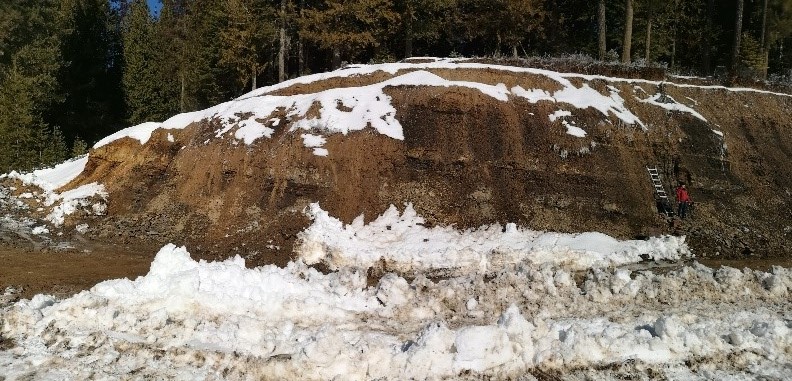
In northwest Idaho, ‘Clarkia Lake’ is an ancient lake formed after massive basalt eruption during the Columbia River Volcanism, that dammed a local drainage. The lake is located in a property that belongs to the family of Kienbaum who allowed research in their area since the 1970s. Remarkably well-preserved fossil leaves, which still retain the original color of the leaves, have been found in the Clarkia Lake, which may hold the key to examine the history of CO2 variation during the past.
For this purpose, an interdisciplinary study consisting of biomarker identification and quantification, stable carbon and nitrogen isotopic analysis, X-ray fluorescence, microscopic petrography, U-Pb zircon dating, and paleobotanic approaches including stomatal analysis are being conducted on samples collected from the Clarkia Lake.
Fieldwork at Clarkia Lake and paleoclimate studies
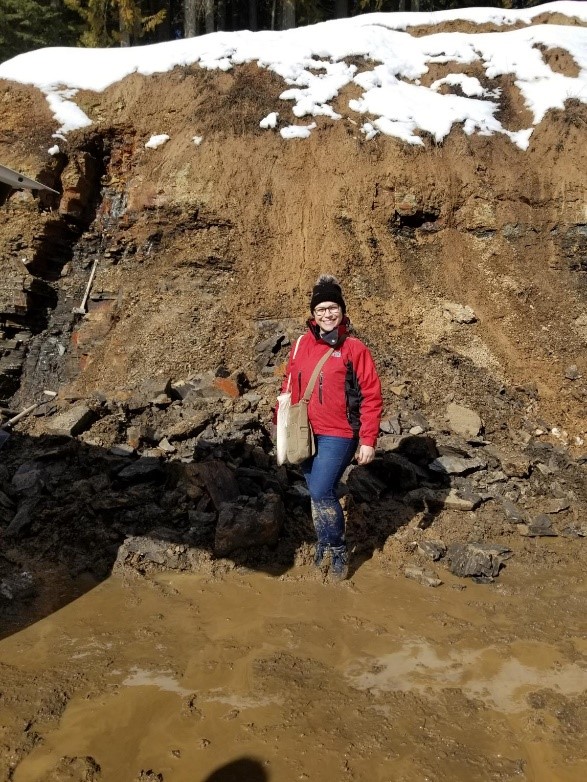
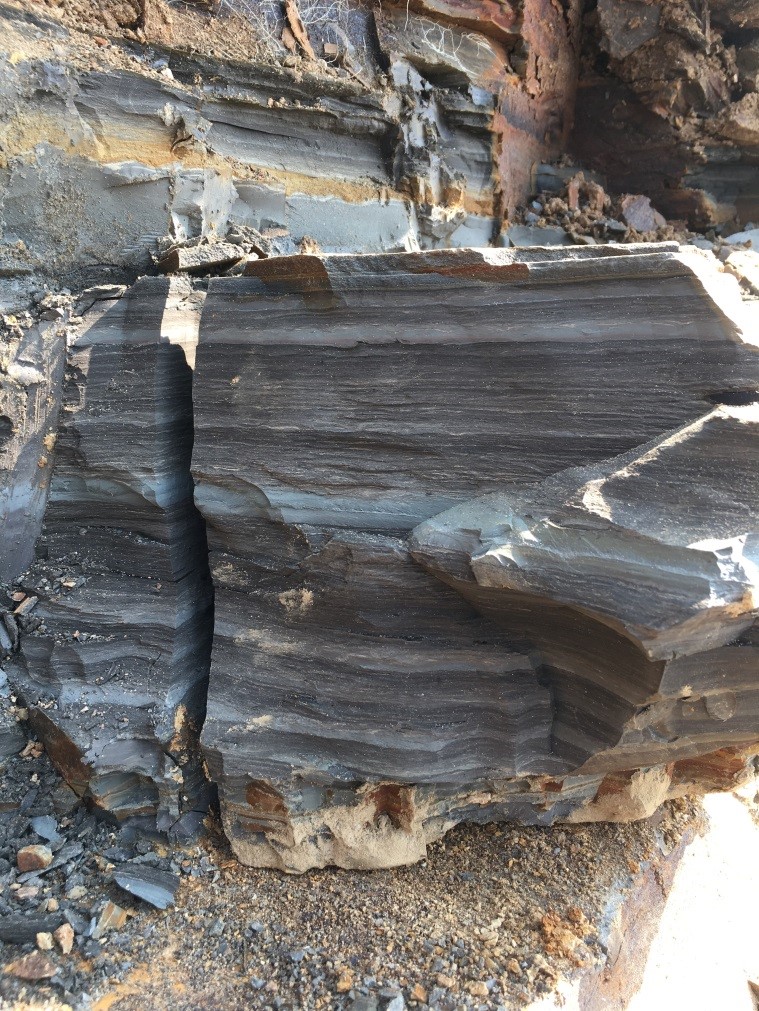
Laminations of the Clarkia Lake sediments presumably respond to the seasonal changes of precipitation and runoff. (Photo courtesy of Dr. Yige Zhang.)
From March 9 to 14, graduate student Daianne Höfig visited Clarkia Lake to collect leaf fossils.
“The field trip was a remarkable experience!” Höfig said. “It was my very first time in the northwest United States and I was impressed by the vast fields covered in snow. Despite the cold temperatures, one day we collected samples at 25 °F (nearly –3 °C).”
During the field trip, Höfig’s dug frozen rocks on the outcrop of the lake, and collected sedimentary blocks which contained leaf fossils.
“I have never seen such incredible preserved fossils before,” she said. “Once the broken rock exposes the fossil leaf, its colors are very intense: from red, typical of fall season, to green ones, as fresh as today’s leaves. It is hard to believe that they are 15 million years old! After some minutes, in contact with the air, these leaves oxidize changing to black color. It was a magical feeling to witness such pellicular phenomenon!”
In the lab, the researchers are conducing several experiments to gather data about not only the fossil leaves, but the Clarkia Lake deposit itself. Their inorganic studies are focusing on determining the sedimentation rates and processes of the deposit, while their organic research aims to understand the climate sensitivity of the middle Miocene.
Sedimentary sequences were also analyzed using X-Ray fluorescence scanning facilities at the International Ocean Discovery Program. The resulting elemental ratios clearly distinguish fossil-rich from barren fossil layers.
The research team has planned further petrographic studies to understand the depositional process within the sedimentary sequence. In addition, volcanic ash layers synchronic to the Clarkia deposit were processed for zircon U-Pb dating, which will yield absolute age control for the paleolake.
Höfig is working on collecting and identifying the fossils leaves from the collected rock samples. In addition, the team will extract lipid biomarkers, and conduct compound-specific carbon isotope analysis.
“I want to first acknowledge my advisor, Dr. Yige Zhang, for letting me participate in this great project,” Höfig said. “As a young scientist, it is inspiring to be part of a research that covers so many different aspects within the geosciences.”
“This is a striking project because it couples the information from extraordinary fossils of 15 million years old with climate change, one of the most pressing issues of today’s society,” she said. “It is equally important to understand how small organic molecules keep secrets about the climate of bygone geological time.”
By Bumsoo Kim
